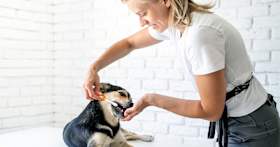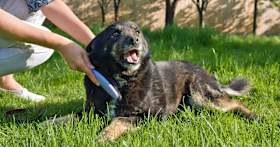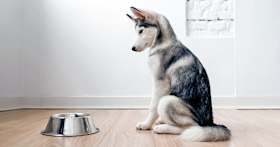Yes, You Need to Brush Your Dog’s Teeth. Here’s Why
Also, learn about a step-by-step way to peacefully introduce them to toothbrushing as a way to maintain their health.
Also, learn about a step-by-step way to peacefully introduce them to toothbrushing as a way to maintain their health.
by Adrienne A. Kruzer, BBA, RVT, LVT, | April 23, 2025

Roman Chazov / Shutterstock
You may not think your dog’s teeth need to be brushed, but these important chewing components do require regular attention. Most vets recommend brushing your dog’s teeth daily or at least a few times a week.
Daily brushing may sound like a lot, but there’s a reason for it, starting with how dogs used to eat. In the wild, dogs would use their teeth to tear away meat and chew on bones to get their food. These natural actions helped keep their teeth free of plaque and tartar. As a pet, though, your dog doesn’t have to work as hard to get their meals, so food particles, saliva, and bacteria can build up on their teeth. These things turn into plaque and eventually harden into tartar.
Without brushing your dog’s teeth, this plaque and tartar can contribute to some serious health issues. In 2023, 73 percent of dogs seen at Banfield were diagnosed with dental-related issues. And dogs with advanced periodontal disease? They were 2.3 times more likely to develop chronic kidney disease and a whopping 6.3 times more likely to end up with endocarditis, an infection of a heart valve. So yeah, brushing matters — a lot.
Banfield Pet Hospital® is offering new clients a coupon for a free first veterinarian visit! (Terms apply.) Book yours now at one of their 1,000+ locations.

You should brush your dog’s teeth daily. But at a minimum, it’s recommended by veterinarians that you brush your dog’s teeth at least three times a week. Otherwise, saliva and food particles will build up in their mouth and begin to mineralize and harden into tartar if not removed in a prompt, consistent basis.
Toothbrushing can begin as soon as your dog gets their puppy teeth, although starting this young is more for training purposes than dental hygiene. As your puppy ages, they will lose all their baby teeth that you worked hard to keep clean, but the effort is worth it: When their adult teeth emerge, your puppy will be used to having their teeth brushed. This will make it less stressful to continue brushing their teeth daily.
The only exception to daily brushing is if your dog is experiencing pain in their mouth. In this case, you should stop brushing their teeth. This could occur when your puppy is temporarily cutting a new tooth, because of an injury near or in the mouth, or if they have periodontal disease. If you suspect your dog is in pain, contact your veterinarian.
Research shows extra-small breeds (under 14 pounds) are up to five times more likely to develop periodontal disease than larger dogs or giant breeds, and senior dogs are more susceptible too. Banfield data backs that up — eight of the top 10 breeds with the highest rates of oral health issues last year were on the smaller side, such as Chihuahuas, Yorkies, and Dachshunds. So if you’ve got a little dog, regular brushing isn’t optional; it’s incredibly essential to their health. This also means that most dogs will experience dental issues at some point in their lives, but regular brushing can help immensely.
Gum inflammation, tooth loss, bad breath, jaw-bone loss, and pain can all occur with periodontal disease — but not all of these conditions are obvious.
Bad breath can occur after your dog eats something especially stinky, but if that bad breath is constant and worsening, this could be a sign of a more serious issue. Other signs of dental issues can include excessive drooling, blood in the mouth or saliva, difficulty chewing, pain when chewing, chewing on just one side of the mouth, and a reluctance to eat. If you notice that your dog has any of these symptoms, make an appointment to see your veterinarian.
The benefits of regular toothbrushing go far beyond what you can see in your dog’s mouth. As with your own teeth, regular brushing freshens your dog’s breath and removes food particles, bacteria, and plaque from their teeth. But that’s not all it does. The proactive brushing action also helps prevent hard tartar from forming on the teeth as well as serious periodontal, heart, kidney, and liver disease that may result from bacteria in the mouth. These diseases can lead to pain, tooth decay, bone loss, heart failure, kidney failure, and liver inflammation.
Another benefit of regular toothbrushing is that you may be able to avoid costly dental procedures if you give your dog’s teeth the attention they need. Your veterinarian may need to anesthetize your dog to clean and examine their teeth, even if you brush them regularly. But with good dental hygiene practices, your dog is less likely to need dental extractions, antibiotics, pain medications, and other oral procedures that may hurt your wallet.
Banfield Pet Hospital® can help your pet live their happiest, healthiest life. Read more vet-approved healthy tips and tricks on how to best care for your BFF.

It’s never too late to start brushing your dog’s teeth, but some dogs who aren’t used to having their teeth brushed may resist it. You may also be unable to reverse existing dental disease by simply brushing the teeth, so a professional dental cleaning at your vet’s office may be necessary. Here are a few tips to help you get started.
Get prepped: Obtain an appropriately sized toothbrush and dog-safe toothpaste. Remember, toothpaste made for humans is not okay for dogs.
Help your dog get comfortable with lip and mouth touch: Get your dog used to having their mouth touched, so they are less reactive to the brushing. Give them tons of encouragement and use treats, petting, and verbal praise to encourage your dog to accept having their mouth touched. If you notice any signs of fear, it’s better to try again later.
Introduce the toothpaste on your finger: Let your dog sniff and taste the toothpaste off of your finger. Again, use positive reinforcement when your dog shows interest in the toothpaste. Keep introducing them and keeping all interactions positive, it might take some time for them to get comfortable.
Introduce the toothbrush: Allow your dog to sniff and lick the toothbrush. Bring it up to their face and show it to them. Give them more treats, pet them, and give them verbal praise as they show interest in the toothbrush and toothpaste.
Finally, begin brushing your dog’s teeth: Gently hold your dog’s mouth shut and start by brushing their back teeth. Allow your dog to lick and swallow the toothpaste as you brush all their teeth. You may need to stop to give your dog breaks if they begin to become stressed during the brushing session. That’s OK. Try again later, keeping it positive.
Over time, you can work your way to more teeth as they get more comfortable and associate toothbrushing with treats and praise.
Although brushing your dog’s teeth daily is always best, you may need to explore other options if your dog will not tolerate toothbrushing.
Dogs are natural chewers, and this behavior is great for keeping their teeth clean. The Veterinary Oral Health Council (VOHC) lists treats and edible dental chews that have been proven to help keep teeth clean. They also recommend (inedible) chew toys designed for oral health. These options won’t completely replace daily brushing, but they will help.
Like edible treats and chew options, the VOHC also recommends oral rinses, sprays, and gels that are proven to improve your dog’s oral health. These rinses, sprays, and gels can be used each day, but shouldn’t completely replace daily brushing.
Even if you brush your dog’s teeth each day, they may still require professional dental cleanings from time to time. These are performed at your veterinarian’s office with your dog under general anesthesia. This allows the vet to fully examine and clean your dog’s teeth. If diseased teeth are found during a dental cleaning, your veterinarian will likely recommend extracting them to prevent continued pain and more serious issues from developing.
Plaque accumulates daily and can turn into tartar after just a couple of days. Tartar cannot be removed by brushing your dog’s teeth, so the longer you go without brushing them, the more likely it is for tartar to develop.
Gum inflammation and bleeding, bad breath, and plaque and tartar buildup are all signs that your dog needs more frequent toothbrushing. If you aren’t already brushing your dog’s teeth daily, you should try to increase the frequency.
Yes, if you brush your teeth more than once a day or for extended periods, you may cause trauma to the gums. Avoid brushing your dog’s teeth more than once a day.
Dogs over the age of three and small breed dogs may need yearly professional cleanings, but this will vary. If you brush your dog’s teeth regularly or offer effective alternatives, your dog may not need their teeth cleaned professionally as often.
A dog who is missing teeth has either lost them due to disease or injury, never developed them as an adult, or has impacted teeth that are still below the gumline. If your dog is missing teeth, you do not need to brush the gums in these areas.
The best toothbrush for your dog is one that easily fits into their mouth. Try using a finger brush if a traditional toothbrush is difficult to use or not tolerated by your dog.
No, you should avoid using human toothpaste for your dog. Human toothpaste may contain ingredients that are harmful to your dog.
No, baking soda can not only upset your dog’s stomach, but it also doesn’t taste very good. These things can cause your dog to vomit and develop a reluctance to having their teeth brushed.
Banfield Pet Hospital. “State of Pet Dental Health: Significant Majority of U.S. Dogs and Cats Have Oral Health Issues.” Banfield Pet Hospital.” Banfield Pet Hospital, 16 Feb. 2024, www.banfield.com/about-banfield/newsroom/press-releases/2024/state-of-pet-dental-health. Accessed 23 Apr. 2025.
“Accepted Products | Veterinary Oral Health Council.” Veterinary Oral Health Council, vohc.org/accepted-products.
Belvoir Media Group. “Periodontal Disease.” Cornell University College of Veterinary Medicine, 3 Jan. 2023, www.vet.cornell.edu/departments-centers-and-institutes/riney-canine-health-center/canine-health-information/periodontal-disease.
“Brushing Is Best for Pet Dental Health - Veterinary Medicine at Illinois.” Veterinary Medicine at Illinois, 2022, vetmed.illinois.edu/pet-health-columns/brushing-is-best-for-pet-dental-health.
“Brushing Your Dog’s Teeth.” Vca_corporate, vcahospitals.com/know-your-pet/brushing-teeth-in-dogs.
“Dental Sprays.” Cornell University College of Veterinary Medicine, 2024, www.vet.cornell.edu/departments-centers-and-institutes/riney-canine-health-center/canine-health-information/dental-sprays.
“How Often Should You Brush Your Dog’s Teeth? Dental Care for Pups.” Kinship.com, 2024, www.kinship.com/dog-health/how-often-should-you-brush-your-dogs-teeth.

Adrienne Kruzer is an accomplished veterinary technician and writer with over 15 years of hands-on experience caring for domestic and exotic animals.

Pet Wellness

Pet Wellness

Adoption Advice

Adoption Advice
Are you new to dog adoption? We’ve got you covered with this comprehensive checklist. It’s everything a first-time pet parent needs to prepare for their new pup.

Adoption Advice
Wondering what to expect from your puppy’s first vet visit? Read more to learn about how to prepare and what to expect.

Adoption Advice
It’s a big decision, so check these boxes before you sign on the dotted line.

Adoption Advice
Adopting a new puppy? We've created a checklist to help you get organized before bringing your new friend home.


Pet Wellness
Regular vet visits are key to keeping your pet healthy. Here’s what happens during a checkup, when to get them, and what to bring.